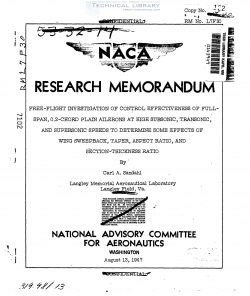naca-rm-l7f30
- Version
- 238 Downloads
- 683.93 KB File Size
- 1 File Count
- March 14, 2017 Create Date
- March 14, 2017 Last Updated
National Advisory Committee for Aeronautics, Research Memorandum - Free Flight Investigation of Control Effectiveness of Full-Span, 0.2 Chord Plain Ailerons at High Subsonic, Transonic, and Supersonic Speeds to Determine Some Effects of Wing Sweepback, Taper, Aspect Ratio, and Section-Thickness Ratio

Effect of secticn thickness ratio.- The effect of section-
thickness ratio on aileron effectiveness for £50 sweptback, untapered
wings is shown in figure 6. In general, the aileron characteristics
for the two section-thickness ratios (0.06 and 0.09) investigated
are in agreement except at the higher Mach numbers Where the lover
effectiveness of the thinner section is attributed to greater wing
twisting. For both configurations the rolling effectiveness
decreased with increasing Mach number for the Mach number range
investigated.
Effect of taper ratio.- The effect of taper ratio on the
rolling power of plain ailerons of 45° sweptback wings of aspect
ratio 3 and NADA 65~009 airfoil section is shown by the comparison
of the result for models 53a and 55a, figure 6. Whereas the
variation of pb/ZV over the Mach number range investigated is
substantially smooth for the untapered wings, a small abrupt loss
in effectiveness is measured for the tapered wings in the Mach
number range from about 0.92 to 1.00. Above Mach number 1.0, the
rolling effectiveness decreases with increasing Mach number over
the Mach number range investigated.
Effect.of aspect ratio.- The effect of aspect ratio on the
rolling effectiveness of the ailerons tested on unswept, untapered
wings of NACA 65-009 airfoil section is shown in figure 7. The
aileron-effectiveness characteristics as a function of Mach number
are, in general, the same for the two aspect ratios investigated
with the exception that, for the lower aspect ratio wings, the
break in the effectiveness curves occurs at a slightly higher Mach
number. The aileron effectiveness for the low-aSpect-ratio con-
figurations is markedly greater over the entire Mach number range
investigated.
At Mach numbers above 1.0 the lower aspect ratio
wing retains a larger part of the subsonic rolling effectiveness
than does the higher aspect ratio wing. Above Mach number 1.0,
the rolling effectiveness for both configurations decreased with
increasing Mach number. Both configurations exhibited undesirable
control characteristics at transonic speeds. In examining the
lab/2v data in the Mach nwnber range from 0.9 to 1.0, figure 7,
it should be noted, as pointed out in reference 1, that the effects
of finite rolling moment of inertia on the instantaneous values
of pb/EV can be relatively large, of the order of $20 percent,
for abrupt changes in pb/EV. For gradual changes in pb/EV the
effect of finite moment of inertia is negligible. Part of the
differences in the rolling power of models 50a and 50b and models 57a
and 57b is due to inadvertent differences in aileron deflections.
The average aileron deflections for models 50a, 50b, 57a, and 57b
were approximately h.h°, h.0°, and 5.00, respectively. No attempt
has been made to correct the pb/ZV data to a common aileron
deflection because the variation of the aileron effectiveness with
deflection is uncertain.
| File | Action |
|---|---|
| naca-rm-l7f30 Free Flight Investigation of Control Effectiveness of Full-Span, 0.2 Chord Plain Ailerons at High Subsonic,.pdf | Download |

Comment On This Post